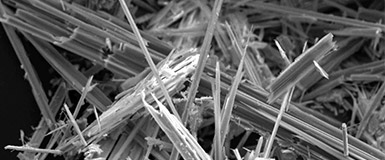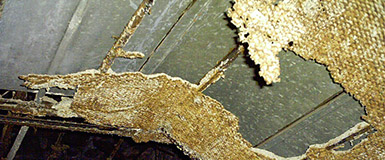Why is asbestos dangerous?
Asbestos fibres are present in the environment in Great Britain so everybody is
exposed to very low levels of fibres. However, a key factor in the risk of developing
an asbestos-related disease is the total number of fibres breathed in. Working on
or near damaged asbestos-containing materials or breathing in high levels of asbestos
fibres, which may be many hundreds of times that of environmental levels, could
increase your chances of getting an asbestos-related disease.
When these fibres are inhaled they can cause serious diseases which are responsible
for around 4000 deaths a year. There are four main diseases caused by asbestos:
mesothelioma (which is always fatal), lung cancer (almost always fatal), asbestosis
(not always fatal, but it can be very debilitating) and diffuse pleural thickening
(not fatal).
Remember, these diseases will not affect you immediately but later on in life, so
there is a need for you to protect yourself now to prevent you contracting an asbestos-related
disease in the future. It is also important to remember that people who smoke and
are also exposed to asbestos fibres are at a much greater risk of developing lung
cancer.
What does Asbestos look like?
Click the thumbnail image:
Asbestos fire blanket

You are mostly at risk when:
- You are working on an unfamiliar site.
- The building you are working on was built before the year 2000.
- Asbestos-containing materials were not identified before the job was started.
- Asbestos-containing materials were identified but this information was not passed
on by the people in charge to the people doing the work.
- You don’t know how to recognise and work safely with asbestos.
- You know how to work safely with asbestos but you choose to put yourself at risk
by not following proper precautions, perhaps to save time or because no one else
is following proper procedures.
Remember- the asbestos management is down to risk assessment.
- You can’t see or smell asbestos fibres in the air.
- The effects of asbestos take many years to show up - avoid breathing it in now.
- Smoking increases the risk many times.
- Asbestos is only a danger when fibres are made airborne.

Are you sure you don’t come into contact with asbestos?
If you work in any of the following occupations, and are working on a building built
or refurbished before 2000, you may come in to contact with asbestos:
- Heating and ventilation engineers.
- Demolition workers.
- Carpenters and joiners.
- Plumbers.
- Roofing contractors.
- Painters and decorators.
- Plasterers.
- Construction workers.
- Fire and burglar alarm installers.
- Shop fitters.
- Gas fitters.
- Computer installers.
- General maintenance staff eg caretakers.
- Telecommunications engineers.
- Building surveyors.
- Cable layers.
- Electricians.
This list does not include all occupations where you may come in to contact with
asbestos. It’s not easy to tell asbestos from how it looks, and it needs to be properly
identified:
- Asbestos used as packing between floors and in partition walls.
- Sprayed ('limpet') asbestos on structural beams and girders.
- Lagging on pipework, boilers, calorifiers, heat exchangers etc
- Asbestos insulating board - ceiling tiles, partition walls, service duct covers,
fire breaks, heater cupboards, door panels, lift shaft lining, fire surrounds, soffits
etc.
- Asbestos cement products such as roof and wall cladding, bath panels, boiler and
incinerator flues, fire surrounds, gutters, rainwater pipes, water tanks etc.
- Other products such as floor tiles, mastics, sealants, rope seals and gaskets (in
pipe work etc.), millboard, paper products, cloth (fire blankets, etc.) and bituminous
products (roofing felt, etc)